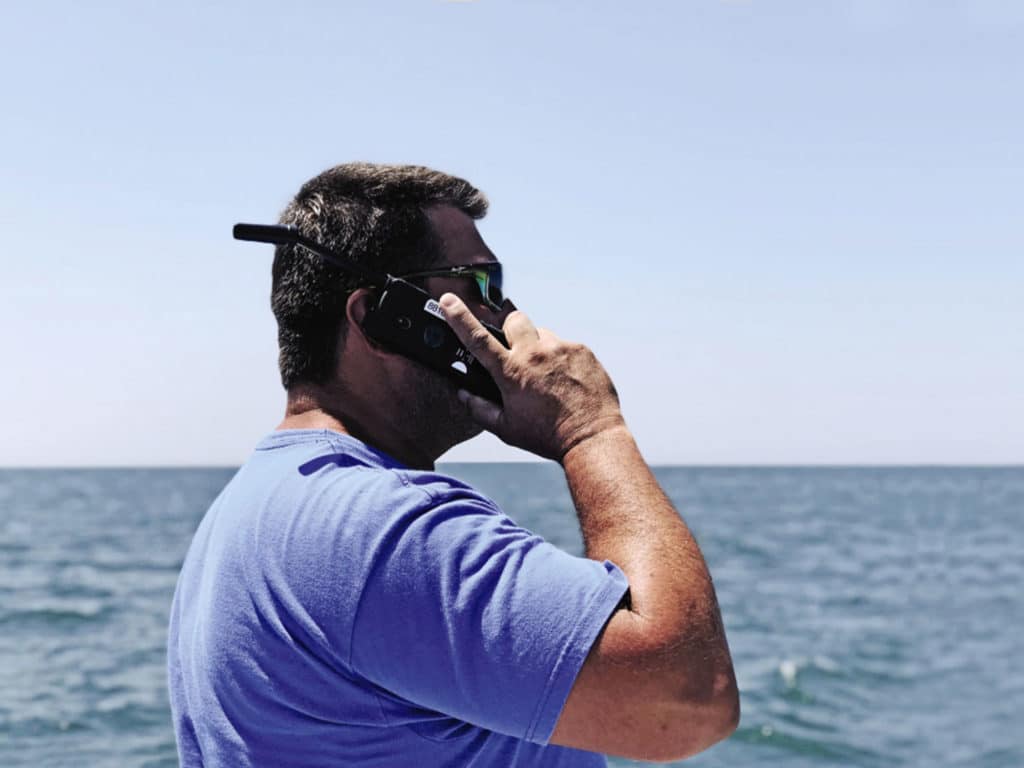
There was a time when cruising meant stepping off the map’s edge and enjoying days, weeks, months or—for the fortunate few—years away from life’s everyday hustle. Untethered from a landline, just communicating by snail mail posed challenges. Now, for better or worse, the modern world has caught up. While there’s no question that this has changed the face of cruising, modern conveniences such as satellite phones and satellite-communication systems have flung the door wide open to itineraries that involve a blend of sailing and work, all while staying in touch with friends and family. So, while that silence in some remote anchorage might occasionally get punctuated by a ringing intrusion, it’s also plenty possible that this same communications line can enable the adventure of a lifetime. Here’s a look at satellite data and phone options for a variety of time frames and budgets.
A Midsummer’s Cruise
If you’re headed off sailing for a typical summer vacation, a satellite phone can be a great way of keeping in touch, accessing up-to-date GRIB files for weather routing, and, if your chosen data plan supports it, sending and receiving emails and texts.
One option that will keep you connected no matter the destination is the Iridium 9575 Extreme. Unlike feature-rich smartphones, the Extreme delivers voice, text and email capabilities using Iridium’s network of 66 low-Earth-orbit satellites. The phone features IP65 weather protection and impact resistance, a user-friendly interface, a rechargeable battery that delivers four hours of active airtime or 30 hours of standby usage, and an SOS button that connects a user with the privately operated GEOS International Emergency Response Coordination Center once the phone has been properly registered. Moreover, the Extreme includes location sharing and tracking features, allowing friends and family to follow and track your travels, and its data-tethering capabilities allow users to download GRIB files via their computers. Sailors can buy or rent an Extreme from vendors, including satellitephonestore.com, which offers airtime starting at $55 per month for 10 minutes of voice calls and 10 text messages.
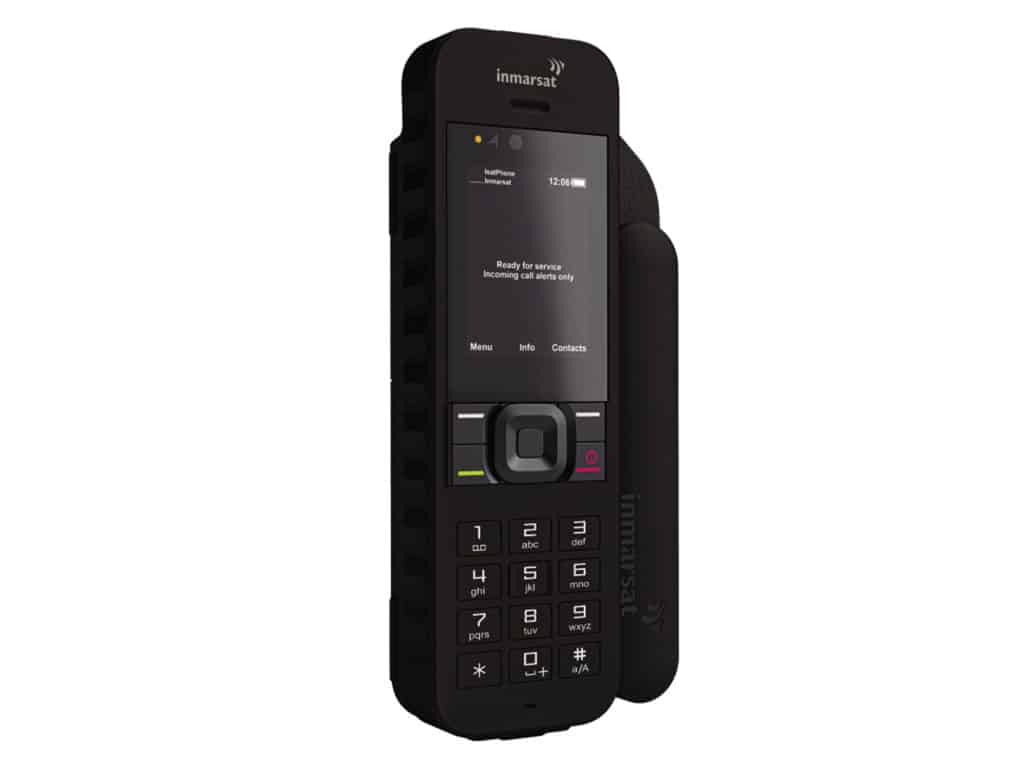
If your cruising itinerary doesn’t venture into the polar regions, Inmarsat’s IsatPhone2 is another option to consider. The phone’s foldout antenna allows it to connect with Inmarsat’s network of four I-4 geostationary satellites, which provide near-global coverage, though not in the extreme high latitudes. In addition, the unit features a high-visibility display, dust-, splash- and shock-resistant construction (IP65-level protection), and an emergency-assistance button that calls a user’s preprogrammed contact or, alternatively, can be preprogrammed to send a text or email message to multiple recipients. The IsatPhone packs a powerful battery that delivers up to eight hours of talking time or up to 180 hours of standby time. Additionally, the phone can be used to send and receive texts and email and share GPS location data. The IsatPhone 2 is available from vendors with or without service plans, which start at $35 per month for 10 minutes of voice calls.
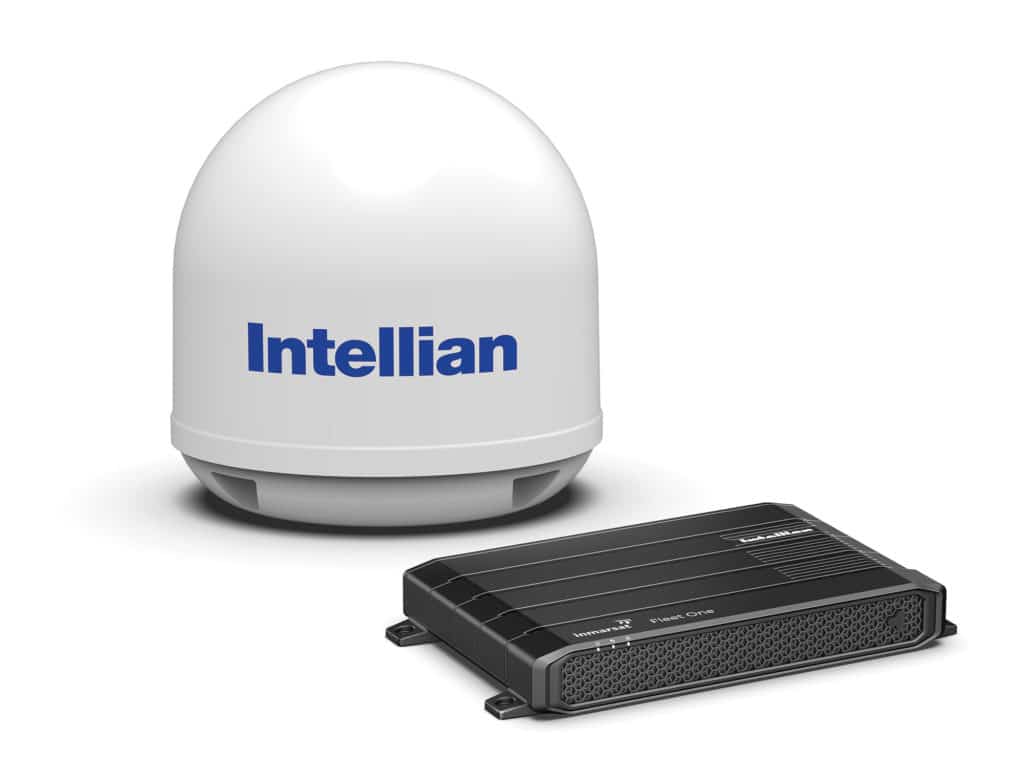
If you want a moderately priced satellite phone and don’t require near- or complete-global coverage, Globalstar’s GSP-1700 could be your answer. The phone features a foldout telescoping antenna, a simple backlit four-line LCD display and an illuminated alphanumeric keyboard. The phone’s rechargeable lithium-ion battery lasts for four hours of voice calls or 36 hours in standby mode. The 1700 can also be used as a satellite modem, allowing users to tether their computers to the internet, however this requires additional cabling (see globalstar.com for details). At present, Globalstar is offering previously owned GSP-1700 phones for free with activation of any of its subscription plans, which start at $80 per month for 150 minutes of airtime, however users should read the fine print related to roaming and long-distance calls and rollover minutes. Alternatively, sailors can purchase the phone, with or without monthly or annual data plans, from a variety of vendors.
A Sabbatical Year
While any of the phones discussed above would be appropriate for a longer cruise when paired with a bigger data plan, a satellite hotspot (sometimes called a Sat-Fi connection), allows users to share connectivity among multiple wireless devices and computers.
If your itinerary includes North America, the Caribbean and/or Europe, Globalstar’s Sat-Fi2 Satellite Hotspot lets you connect up to eight smart devices to your own Sat-Fi network via Globalstar’s dedicated companion app. The hotspot includes an attached antenna, so the device is portable and does not require installation. It delivers a Wi-Fi range of up to 50 feet, and comes with an assigned US phone number. The hotspot can be purchased directly from Globalstar with a user’s choice of eight different data plans, ranging from the $40 per month Advantage 40 plan (40 minutes of voice time, 25 texts and 5MB of data) to the $2,400-a-year Enterprise 6000 plan that comes with 6,000 minutes of voice time, 6,000 texts and 900MB of data. The hotspot can also be bought from vendors, which sell the device with or without a data plan; rentals are also available. One thing to consider before purchasing: The hotspot provides data speeds up to 72 Kbps, which will feel downright pedestrian compared with high-speed internet, so scale your data-use expectations accordingly; also, pay close attention to the small print regarding data-overage costs.
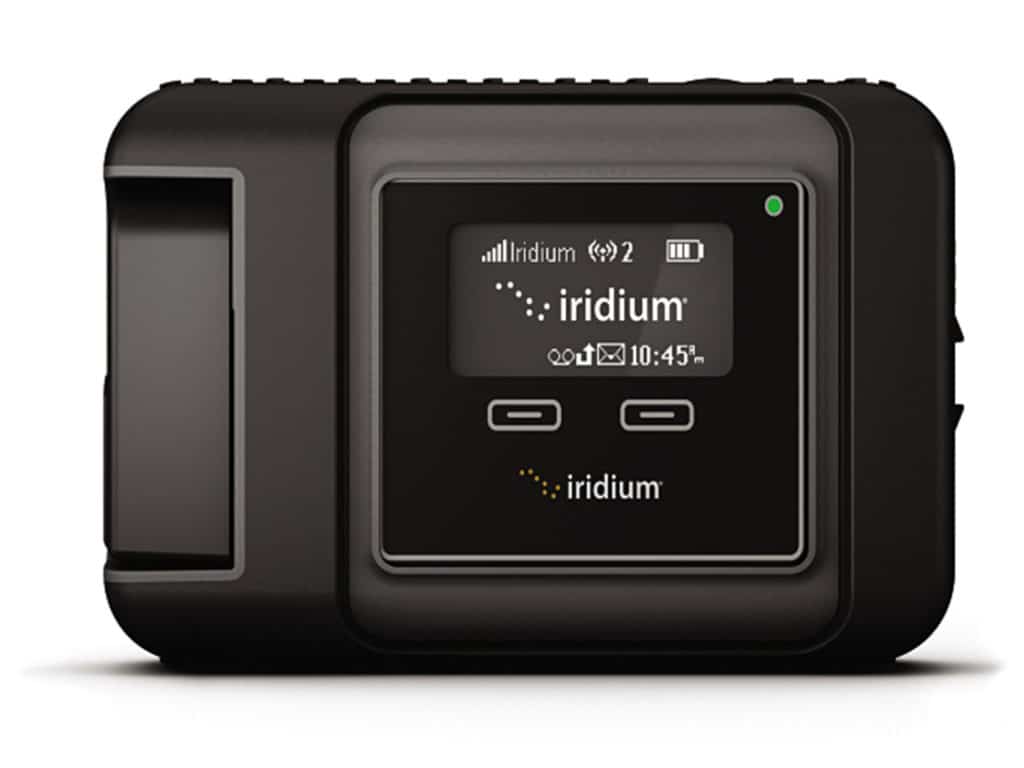
Sailors planning on continent hopping should check out the Iridium Go. This self-contained system provides a 100-foot Wi-Fi radius and can support up to five devices or computers using dedicated Iridium apps. Users can make calls, send texts and emails, browse the web, and download GRIB files using Iridium apps, which work well with low-bandwidth connections. This last bit is important because the Go’s data-transfer speeds of 2.4 Kbps are slothlike compared with the other equipment discussed in this article. That said, Go is fully global, and it delivers seven hours of talk time or 16 hours of standby time in between recharges. Additionally, Go devices can send emergency communications to GEOS and check-in communications—including GPS information—to friends and family. The device comes with IP65 environmental protections, and one can be rented or purchased with or without data plans from vendors. Iridium plans range from the basic 40 Min Plan ($60 per month, no data included) to the Unlimited Data and SMS Plan ($150 per month; includes 150 minutes of voice calls).
Another option is KVH’s TracPhone Fleet One system, which is comprised of a tidy-size, abovedecks radome-enclosed antenna (it’s 11.5 inches tall, 11 inches in diameter and weighs 8.7 pounds), a belowdecks terminal and a handset. Once installed, users have their choice between KVH’s Fleet One Coastal service, which delivers data (out to roughly 200 nautical miles) and near-global voice calls, and KVH’s Fleet One Global service, which delivers voice and data nearly worldwide (see KVH’s website for details). In both cases, users can expect data-transfer speeds of up to 100 Kbps, clear voice calls, and the ability to send 160-character texts. Owners can add an optional wireless router, which turns the system into an onboard Sat-Fi network that can provide connectivity to any number of devices. In addition to hardware costs and monthly airtime rates ($50 per month for Fleet One Coastal, which includes 10MB of data and 100 minutes of voice calling, and $130 per month for Fleet One Global, which includes 15MB of data and 250 minutes of voice calling), cruisers will likely need to factor in installation costs, which can vary.
If you like the idea of a small-size, radome-enclosed satellite-communications antenna but want the flexibility of buying airtime from multiple resellers, Intellian’s Fleet One should be considered. The Fleet One’s radome (10.6 inches wide and tall, weighing 11 pounds) delivers clear voice calls, and the hardware is compatible with GSM cellular networks and text systems globally. The Fleet One operates on Inmarsat’s Broadband Global Area Network L-Band service and also delivers strong safety-at-sea functionality, including Inmarsat’s free 505 emergency voice distress calling for small vessels. Conveniently, the Fleet One features built-in Wi-Fi access points, allowing owners to pair their smart devices with the system for making calls or sending texts. Prospective customers will need to purchase the hardware (see Intellian’s website for vendor information), which includes an abovedecks radome-enclosed antenna and a black-box belowdecks unit (in addition to cabling), as well as an Inmarsat BGAN airtime package (these start at $30 per month for 2MB of data). Hardware-installation costs vary based on location and vessel type and the complexity of the installation.
Living the Dream
If a multiyear escape aboard a big bluewater sailboat is the plan, you’ll likely want a satellite-communications system that offers faster speeds, which in turn allows for content streaming. Before you cast off, consider installing a Very Small Aperture Terminal communication system, which can deliver global voice and data.
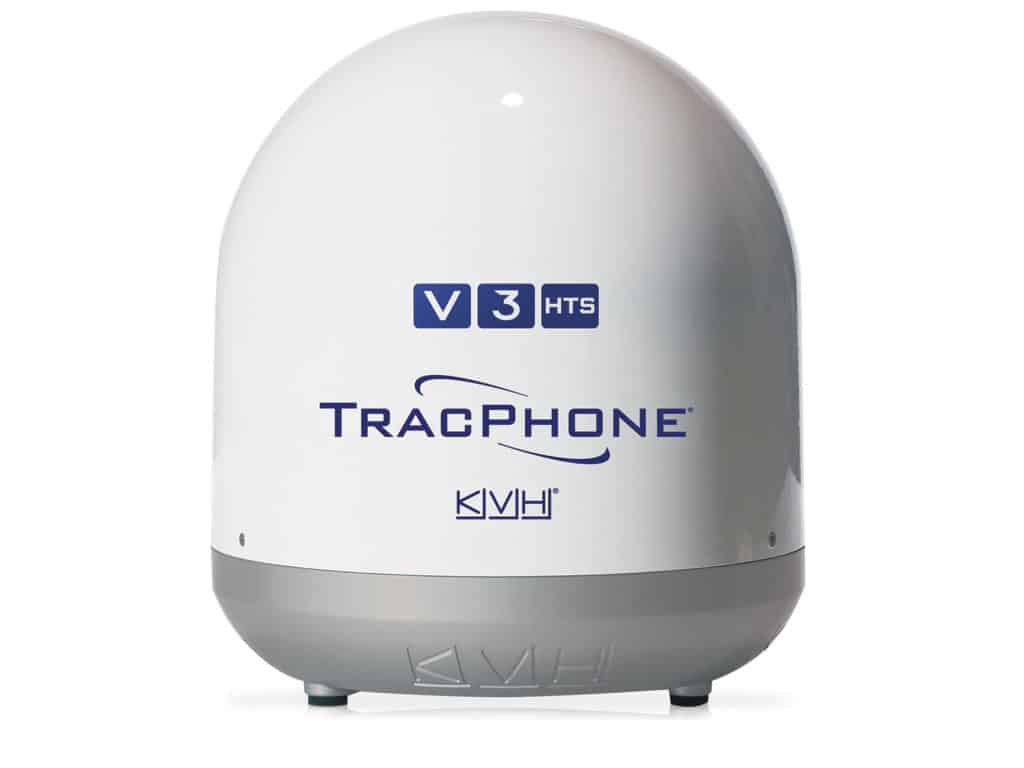
The KVH TracPhone V3-HTS is designed to tackle rough ocean crossings without dropping its signal thanks to its two-axis gyrostabilization. The antenna automatically switches between satellites as a vessel sails, giving sailors a seamless satellite-communications experience, while the system’s built-in firewall provides cyberdefenses. The system operates on Ku-band frequencies that provide coverage in most areas, save the South Pacific (see KVH’s website for coverage maps). The system’s dome antenna measures in at 15.5 inches wide by 17.6 inches tall, and it weighs 25 pounds, making it the smallest Ku-band antenna afloat. An owner can expect clear voice calls and the ability to download data at speeds up to 5 Mbps, while uploading at speeds up to 2 Mbps. Hardware-wise, the system consists of the abovedecks radome and a belowdecks Integrated CommBox Modem, the latter of which features a built-in Wi-Fi router and Ethernet connectivity.
As with all KVH satellite-communications products, the company builds the antennas and also operates its proprietary mini VSAT Broadband HTS network. In addition to hardware and installation costs, airtime prices for the TracPhone V3-HTS start at $100 per month, which includes 200MB of data, and the system includes data-management tools to control costs. For example, an owner can allocate data (daily, weekly or monthly) to crewmembers’ devices. Finally, while the speeds, capabilities and size of the TracPhone V3-HTS are impressive, cruisers are cautioned that it usually requires a fair bit of waterline (say 50-plus feet) and beam to aesthetically accommodate a VSAT radome.
David Schmidt is CW’s electronics editor.








